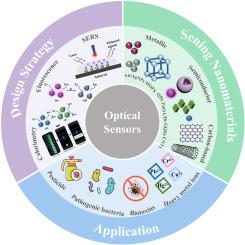用于食品和农业安全检测的纳米材料驱动的多路光学传感器:从传感策略到实际挑战
IF 12
1区 化学
Q1 CHEMISTRY, ANALYTICAL
引用次数: 0
摘要
近年来,食品和农产品中存在的有害污染物对公众健康构成了重大风险。因此,开发快速、准确、广谱的食品危害检测技术至关重要。光学传感具有快速、灵敏度高的优点,将在保障食品安全方面发挥无可比拟的作用。本文综述了基于荧光、表面增强拉曼散射(SERS)、表面等离子体共振(SPR)和比色法的光学系统的基本原理。综述了纳米材料(金属、半导体、碳基)增强光学传感器检测农药、重金属、生物毒素和食源性病原体的能力。此外,本文还讨论了光学传感器的局限性和前景,并特别强调了主要研究成果:1)人工智能优化的纳米材料设计,2)集成智能手机的便携式检测系统,3)自验证双模传感器。这项工作旨在促进高精度传感方法的战略进展,最终保障食品安全。本文章由计算机程序翻译,如有差异,请以英文原文为准。

Multiplexed optical sensors driven by nanomaterials for food and agriculture safety detection: From sensing strategies to practical challenges
In recent years, the presence of hazardous contaminants in food and agricultural products has posed a significant risk to public health. Therefore, it is critical to develop rapid, accurate, and broad-spectrum food hazard detection techniques. Optical sensing has the advantages of rapid and high sensitivity, it will play an unparalleled role in ensuring food safety. This review provides a comprehensive overview of the fundamentals of optical systems based on fluorescence, surface-enhanced Raman scatting (SERS), surface plasmon resonance (SPR) and colorimetry. The ability of nanomaterials (metal, semiconductor, carbon-based) enhanced optical sensors to detect pesticides, heavy metals, biotoxins, and foodborne pathogens is summarized. In addition, this paper discusses the limitations and prospects of optical sensors, and particularly emphasizes the main findings: 1) AI-optimized nanomaterial design, 2) smartphone-integrated portable detection systems, 3) self-validating dual-mode sensors. This work aims to promote strategic advances in high-precision sensing methods that ultimately safeguard food safety.
求助全文
通过发布文献求助,成功后即可免费获取论文全文。
去求助
来源期刊

Trends in Analytical Chemistry
化学-分析化学
CiteScore
20.00
自引率
4.60%
发文量
257
审稿时长
3.4 months
期刊介绍:
TrAC publishes succinct and critical overviews of recent advancements in analytical chemistry, designed to assist analytical chemists and other users of analytical techniques. These reviews offer excellent, up-to-date, and timely coverage of various topics within analytical chemistry. Encompassing areas such as analytical instrumentation, biomedical analysis, biomolecular analysis, biosensors, chemical analysis, chemometrics, clinical chemistry, drug discovery, environmental analysis and monitoring, food analysis, forensic science, laboratory automation, materials science, metabolomics, pesticide-residue analysis, pharmaceutical analysis, proteomics, surface science, and water analysis and monitoring, these critical reviews provide comprehensive insights for practitioners in the field.
 求助内容:
求助内容: 应助结果提醒方式:
应助结果提醒方式:


